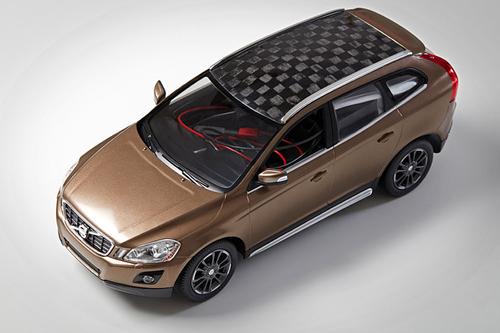Swedish researchers have created a carbon fiber out of wood and used the lightweight, affordable material to make car roofs and even a battery.
March 15, 2016
It's not exactly a classic, wood-paneled surfer's woody, but this small model-sized station wagon has a roof made of wood. That is, it's made of a wood-based carbon fiber composite, and the first model car to have a roof made of this novel, lightweight material. Even more novel is the car's battery, which is made of the same stuff, designed by Swedish researchers.
Composites of various kinds for lightweighting cars aren't new. Neither are wood-based materials. Ford, for example, for several years has been working on wood fiber-based composites of various kinds, as well as investigating other plant fiber-based materials. It's considered wheat straw and coconut fiber composites, in addition to composites made of tomato skins. The company has said it wants to make strong, lightweight composites that reduce its environmental impact, right in line with Ford's continuing sustainability goals for cutting vehicle carbon dioxide emissions and the amount of waste that goes to landfills.

The carbon fiber in this model car's composite roof and battery electrodes are made from a wood lignin developed by Swedish researchers. The new material is not only lightweight, but also cheaper than ordinary carbon fiber since the lignin is made from paper pulp production byproducts.
(Source: KTH Royal Institute of Technology)
Making carbon fiber out of wood, though, is definitely new. It's the result of a joint project of the KTH Royal Institute of Technology, Swedish research institute Innventia, and Swerea, a research group for industrial renewal and sustainable development. The carbon fiber composite contains wood lignin from cell walls, the second-most abundant natural polymer after cellulose. The new composite is not only lightweight, but also cheaper than ordinary carbon fiber.
Goeran Lindbergh, a KTH professor and head of its department of chemical engineering and technology, said he investigated lignin-based batteries in previous work with Innventia using wood lignin as an electrode. Lignin-based batteries can be produced from renewable raw materials such as the paper pulp production byproducts used in the new material. Except for their material composition, batteries made with the new lignin-based carbon fiber composite are the same as traditional batteries.
READ MORE ARTICLES ON COMPOSITES AND RENEWABLE MATERIALS:
One research goal is to come up with structural batteries for use in electric cars. These lignin-based carbon fiber structures would manage mechanical loads, while at the same time also storing electrical energy as an active electrode in lithium-ion batteries. That idea is being pursued by Lindbergh and other researchers at KTH.
Ann R. Thryft is senior technology editor, materials & assembly, for Design News. She's been writing about manufacturing- and electronics-related technologies for 28 years, covering manufacturing materials & processes, alternative energy, machine vision, and all kinds of communications.
Like reading Design News? Then have our content delivered to your inbox every day by registering with DesignNews.com and signing up for Design News Daily plus our other e-newsletters. Register here!
About the Author(s)
You May Also Like



